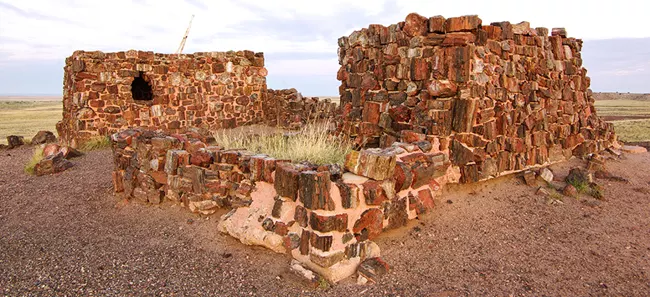The Big Painted Desert
October 19, 2023 – Day 21
We had thought we’d go to Flagstaff and explore there. On the list were the Lowell Observatory and Walnut Canyon plus anything else we could squeeze in. As the early morning unfolded we realized that we needed to go back to the Petrified Forest. The first place was back to the Blue Mesa loop since we wanted to see it fully lit. We also figured out that “road” we had previously seen was, in fact, a short 1 mile trail so we wanted to do that as well. The Blue Mesa loop is in the Petrified National Forest which includes the part of the Painted Desert, the “real” Painted Desert.
The Painted Desert is a United States desert of badlands in the Four Corners area, running from near the east end of Grand Canyon National Park and southeast into Petrified Forest National Park. It is most easily accessed from the north portion of Petrified Forest National Park. The Painted Desert is known for its brilliant and varied colors: these include the more common red rock, but also shades of lavender.
https://en.wikipedia.org/wiki/Painted_Desert_(Arizona)
We went fairly early in the morning. It was about an hour and a quarter to make it to the trailhead, we got there around 10:45 AM. Immediately we saw that the golden hour didn’t matter. This place was spectacular in mid-day lighting. No matter where the sun would be you would see shadows and creases in the rock formations. We didn’t get a single picture at the top, don’t worry, we took lots as we descended and walked the paved trail.
The Blue Mesa Trail is a walk into the heart of Petrified Forest badlands. As you descend into the Blue Mesa basin, you take a walk back in time, each colorful stripe you pass representing years into the past.
Look for the sculptural talents of wind and water on the layers of sedimentary rock. Along the trail are signs that explain the processes that have changed, and are still changing, this landscape.
1.0 miles, paved? Sounds easy right? It only has 120′ of elevation change and (gulp!) up to a 35% slope! Yikes, that’s steep!

Paul had Susan go on ahead for this photo. Look for her down the slope. Still looking pretty easy but she called out to him, “It’s pretty spooky here.”
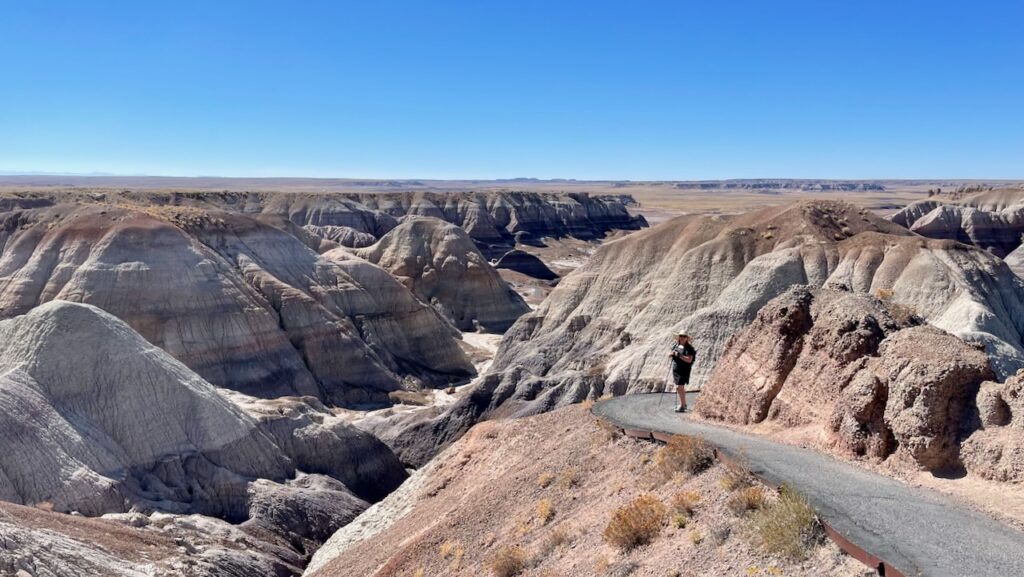
She was right! Until recently Paul has suffered from extreme vertigo. He’s not sure why he no longer suffers from it. Recently he was able to climb the same fire tower that he was unable to climb a few years ago without any feelings of vertigo. But still, the ground dropped away at the bend where Susan is standing. Paul agreed that corner is spooky. You definitely don’t want to trip.
But that’s not the steep part. This is the steep part!

So what “Badlands” anyways? We thought you would never ask.
Blue Mesa is one of the best places in the park for visitors to explore badlands. Badlands are found around the world, usually in arid regions where poorly consolidated rock undergoes infrequent but torrential rain. The soft rock funnels quantities of water down rills, gullies, and washes, the water carrying loads of sediment away. Bentonite clay within the formation can swell up with moisture, shrinking and cracking as it dries, creating an “elephant-skin” surface. Beneath the surface, an intricate maze of natural pipes and spaces form within the badlands. Clues to this hidden natural plumbing manifests on the face of the badlands as dimples in the ground, sinks, slumps, and seeps. As erosion continues, caves and natural bridges can form as the spaces are exposed. Erosion, continues to create new features every year.
Look at the piles of petrified wood which have washed down the crease over the years.
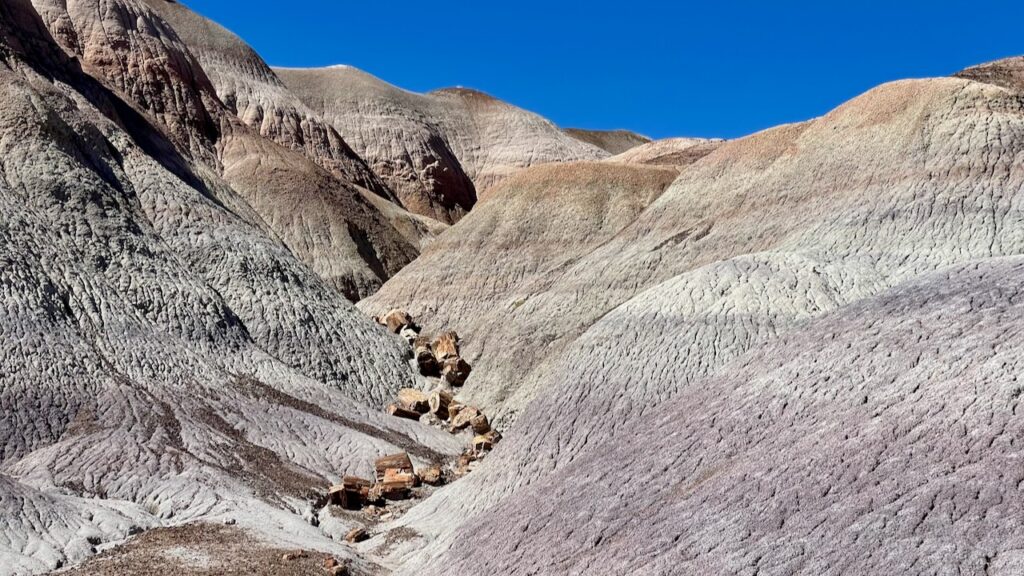

Just like in Carlsbad Caverns, as we walked along we were constantly passed by other people. We never zipped past anyone. It’s not that we’re slow. It’s that we’re gobsmacked by the beauty and move slowly to savor all that the views have to offer. At least we didn’t have to look up like in Carlsbad!
Check out the erosion gully in the foreground, don’t miss the two people off in the distance!

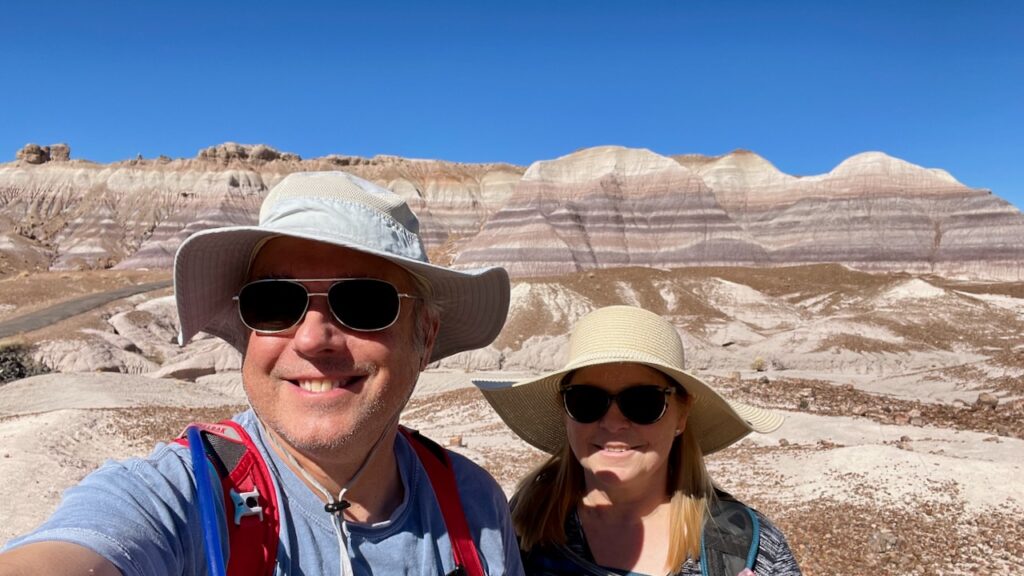
We came across this cool mushroom.

Mushroom? Yes, mushroom.
Mushroom-like pedestals supporting petrified wood pieces are products of water erosion. The softer material beneath the hard caps of petrified wood will eventually erode away, dropping the piece to the ground.
Remember it talked about colorful layers? One of the top layers was a conglomerate rock. As it erodes the clasts roll down the hill. Paul knew what conglomerate is but not what clasts are. It was wild to see all the clasts, aka pebbles, on top of the lower layers. You can also clearly see the fissures in this picture.

We headed back up that 35% to the Blue Mesa Trailhead. The heat was already starting to rise. Between the elevation, the heat and the sun it was really starting to cook us. It was really beautiful but we were happy to be back in the air conditioned comfort of the Jeep.
Soon we were peering down into the Jasper Forest. It’s not really a forest as there are no living trees. It is a plain covered with lots of petrified wood.

We had the option to hike down to the bottom and walk several miles around the piles of wood. Even though the Blue Mesa loop was wonderful. Even if it wasn’t hot neither of us felt compelled to go down there. While interesting to see one piece of petrified wood looks pretty much like any other piece of petrified wood.
Sure enough, right around the corner was the Crystal Forest, at ground level, and only 0.8 miles.

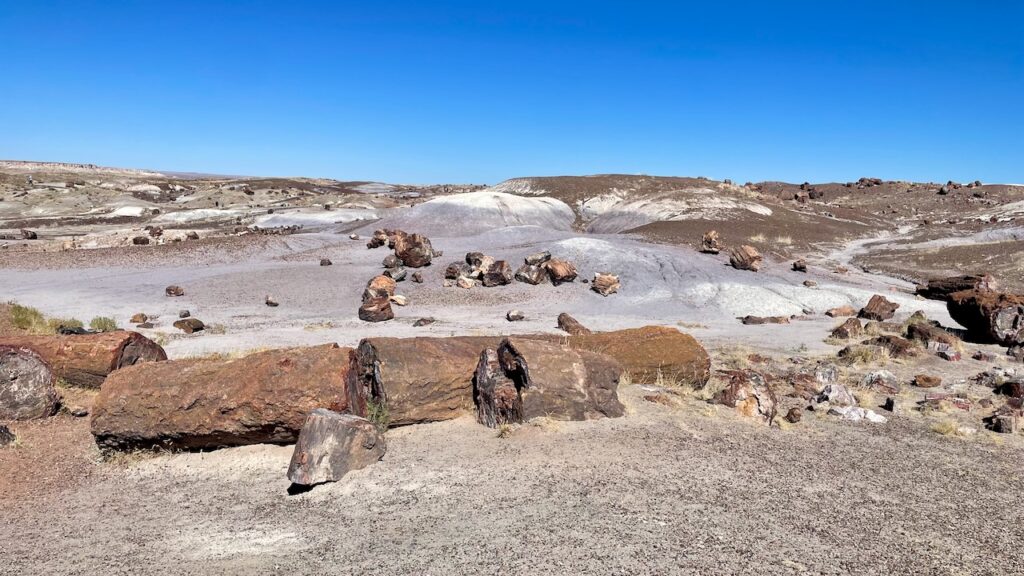
Every so often you’d find a cool piece. Some of the colors were pretty stunning.
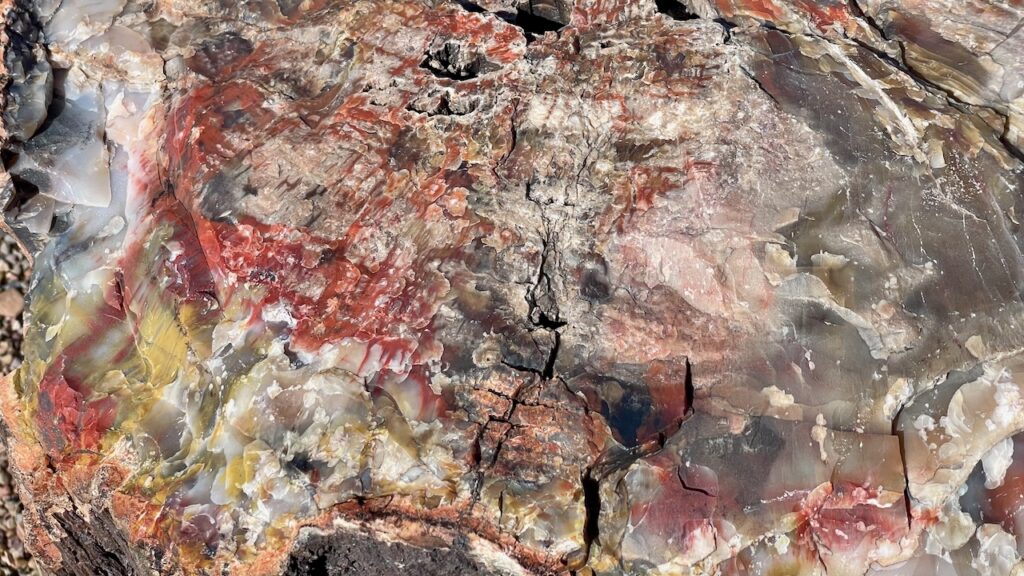
The colors come from the various minerals that soaked into the logs after they had fallen down. White is quartz, neither of us can remember what the other colors meant. We didn’t take a picture of the sign that explained the colors.
On the way out we stopped by a museum which was all about fossils which didn’t hold any interest for us. At the gift shop, they had a 20 minute movie which was definitely time well spent. It talked about both about the formation of the badlands, the woods and much more.
We saw of photo of the Agate House which we both really wanted to see. But it was getting hot and it was a 2.0 mile round trip hike to see it.
Ancestral Puebloan people used petrified wood for a variety of purposes including tools such as projectile points, knives, and scrapers. Agate House demonstrates another innovative use of petrified wood: as a building material. The eight-room pueblo was built and occupied sometime between 1050 and 1300 in a location near agricultural fields and petrified wood deposits. The size of the structure and time necessary to build and maintain it indicates that this was likely a year-round residence for a single family, rather than the temporary residences or field houses common at that time. It may have even served as a meeting place for the surrounding community. The scarcity of artifacts found at Agate House suggest a relatively brief occupation.
The photo and text is from the National Park Service website. Yes, we’ll be coming back a third time to visit this park. There’s still a lot to see.
Daily: 0
Total: 2,916
Moving Miles/Day: 324
Overall Miles/Day: 139
